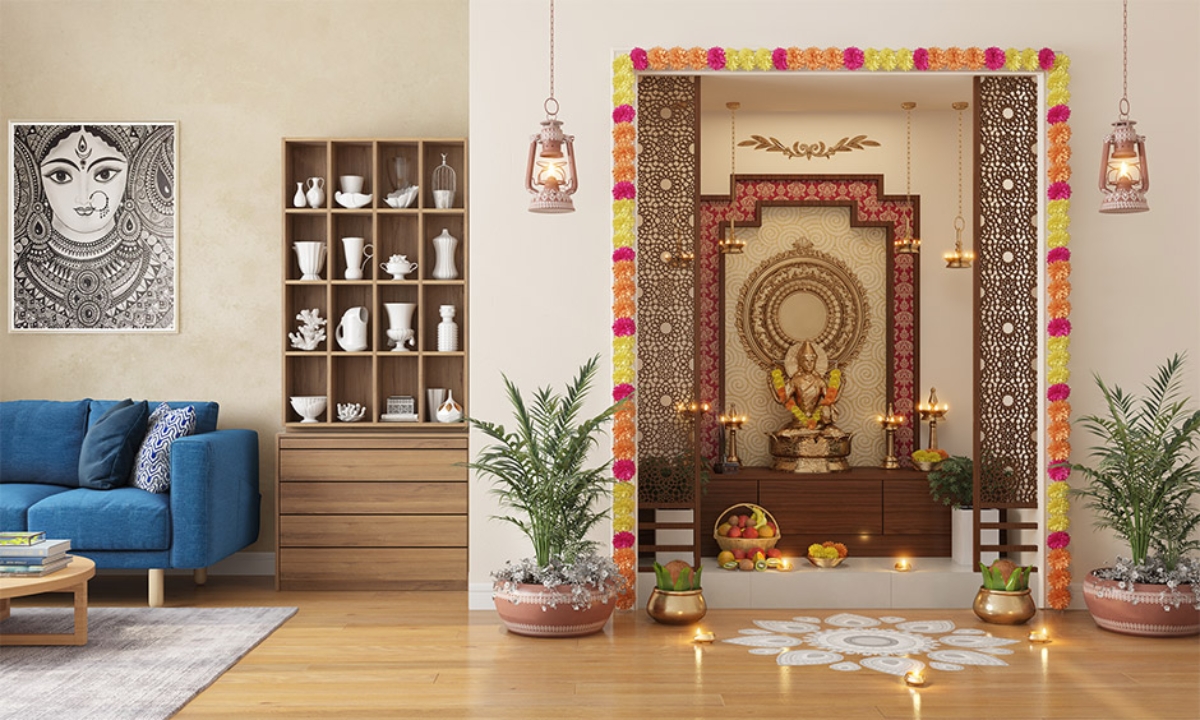Oragadam Township is renowned for its lush greenery, serene environment, and modern amenities. As a resident of Hiranandani Parks in Oragadam, you’re immersed in a community that values tradition and modernity. One of the most cherished spaces in Indian homes is the pooja room, where spirituality meets design. This sacred space serves as a cornerstone for family rituals, offering solace and a connection to one’s cultural heritage. Here are the top 10 pooja room design ideas tailored for your home in Hiranandani Parks, Oragadam:
1. Traditional Elegance: Incorporate traditional elements like brass or copper bells, diyas (lamps), and intricate carvings on wood for a classic look. Use earthy tones for the walls and flooring to create a warm ambience. You can also add a beautiful jali (lattice) work screen or door to enhance the traditional feel. Consider adding a small seating area with cushions for comfort during prayers.
2. Modern Minimalism: Embrace a minimalist approach with clean lines and simple designs. Opt for a sleek, compact pooja unit with concealed storage to keep the space clutter-free. Choose a neutral colour palette with a pop of colour for the accessories to add a modern touch. Incorporate a floating shelf above the pooja unit for displaying decorative items or books.
3. Fusion of Styles: Combine traditional and contemporary elements to create a unique pooja room. For example, you can pair a traditional wooden pooja unit with modern lighting fixtures. Add a touch of luxury with a marble or granite backdrop for the pooja unit. Consider adding a statement piece of art or sculpture that complements the overall theme of the room.
4. Space-Saving Solutions: If you have limited space, consider a wall-mounted pooja unit or a compact corner unit. Use shelves or cabinets above the unit for additional storage. Incorporate a foldable or sliding door for the pooja room to save space. Consider using multipurpose furniture, such as a pooja unit that doubles as a display cabinet or a foldable pooja mandap.
5. Nature-Inspired Design: Bring the outdoors inside by incorporating elements like indoor plants, floral motifs, and natural materials like wood and stone. Use a water fountain or a small indoor waterfall to create a tranquil environment. Consider installing a skylight or a large window to allow natural light to illuminate the pooja room during the day. Use natural materials like bamboo or rattan for furniture to create a harmonious look.
6. Lighting Effects: Lighting plays a crucial role in creating the right ambience. Use soft, warm lighting for a cosy feel or opt for LED strip lights to highlight the pooja unit. Consider installing a dimmer switch to control the intensity of the light. Use decorative lamps or lanterns to add a festive touch during religious celebrations.
7. Colour Palette: Choose a soothing colour palette for the walls and furnishings. Shades of white, cream, beige, or pastel colours can create a serene atmosphere. Add a touch of vibrancy with colourful cushions or rugs. Consider using textured wallpaper or wall panelling to add depth to the room. Use decorative tiles or mosaic work for the flooring to create a focal point.
8. Sacred Geometry: Incorporate sacred geometry elements like mandalas, yantras, or lotus motifs in the design of the pooja unit or on the walls for a spiritual touch. You can also add a beautiful rangoli design at the entrance of the pooja room. Use geometric patterns for the flooring or ceiling to create a sense of harmony. Consider using a stained glass window or panel with geometric patterns for a dramatic effect.
9. Personal Touch: Add personal elements like family photos, heirloom items, or religious scriptures to make the pooja room more meaningful and personalized. Display these items in a tasteful manner to maintain the sanctity of the space. Consider adding a small shrine or niche for displaying personal items. Use custom-made furniture or accessories to reflect your style.
10. Vastu Shastra Compliance: Ensure that the pooja room is designed as per Vastu Shastra guidelines for harmony and positive energy flow. Position the pooja unit in the northeast corner of the room for auspiciousness. Use natural materials like wood and stone for the pooja unit to enhance positive energy. Avoid placing the pooja unit near the bathroom or kitchen, as it is considered inauspicious. Consider installing a curtain or screen to separate the pooja room from other areas of the house.
In conclusion, designing a pooja room in Hiranandani Parks, Oragadam offers a harmonious blend of tradition and modernity. By incorporating elements like traditional elegance, modern minimalism, and a touch of personalization, residents can create a sacred space that reflects their cultural heritage and individual style. With careful attention to Vastu Shastra principles and the infusion of natural elements, the pooja room becomes a sanctuary for spiritual connection and serenity within the vibrant community of Oragadam Township.
Frequently Asked Questions (FAQs)
Q: What are the ideal dimensions for a pooja room in a typical home in Hiranandani Parks, Oragadam?
The ideal dimensions for a pooja room can vary, but a common recommendation is to have a minimum area of 3 feet by 3 feet for a compact pooja unit.
Q: How can I incorporate natural light into my pooja room design?
To incorporate natural light, consider placing the pooja unit near a window or using translucent materials for doors or windows to allow light to filter in.
Q: What are some innovative storage solutions for pooja room essentials?
Consider built-in cabinets, drawers, or shelves within the pooja unit to store essentials like incense sticks, camphor, and prayer books.
Q: How can I ensure proper ventilation in the pooja room?
Proper ventilation can be ensured by installing windows or ventilation fans in the pooja room to allow for fresh air circulation.
Q: Are there any specific design elements to avoid in a pooja room?
Avoid placing the pooja unit under a staircase, in a bedroom, or the basement, as these locations are considered inauspicious as per Vastu Shastra.

